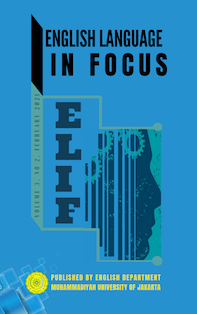Introducing English in Preschool Through Developmentally Appropriate Practice (DAP)
DOI:
https://doi.org/10.24853/elif.3.2.159-168Keywords:
introduction, learning English, preschoolAbstract
This research is aimed to provide a detailed understanding of the implementation of Developmentally Appropriate Practice (DAP) in English teaching at TK Islam Amalina South Tangerang. A qualitative analysis using the ethnography approach was used in the study. The data were gathered through observation, interview, and document review. Research indicates that the objective of the teaching and the method of teaching activities are both consistent with DAP best practices. However, some are not in agreement with the DAP. Furthermore, the topic of discussion was inconsistency. According to the findings of the study, the English teaching at TK Islam Amalina should (1) integrate the child development, subject matters, and language skills, (2) engage children in learning through play, and (3) involve children in learning by doing.References
Betawi, A., & Jabbar, S. (2019). Developmentally Appropriate or Developmentally Inappropriate, That’s the Question: Perception of Early Childhood Pre-Service Teachers at The University of Jordan. International Journal of Adolescence and Youth, 24(1), 40–50. https://doi.org/10.1080/02673843.2018.1458633
Bromley, K. D. (1997). Language Arts: Exploring Connections (3rd ed.). Allyn & Bacon.
Bronson, M. B. (1995). The Right Stuff for Children Birth to Eight: Selecting Play Materials to Support Development. National Association for the Education of Young Children.
Brown, H. D. (2000). Principles of Language Learning and Teaching (4th ed.). White Plains, NY : Longman.
Copple, C., & Bredekamp, S. (2009). Developmentally Appropriate Practice in Early Childhood Programs Serving Children from Birth Through Age 8. National Association for the Education of Young Children.
Edwards, S. (2005). Children’s Learning and Developmental Potential: Examining the Theoretical Informants of Early Childhood Curricula from the Educator’s Perspective. International Journal of Phytoremediation, 21(1), 67–80. https://doi.org/10.1080/09575140500043161
Fromkin, V., Rodman, R., & Hyams, N. (2013). An Introduction to Language (10th ed.). Cengage Learning.
Hadi, M. S. (2019). The Use of Song in Teaching English for Junior High School Student. English Language in Focus (ELIF), 1(2), 7-112. https://doi.org/10.24853/elif.1.2.107-112
Halimah, F., & Izzah, L. (2020). Building FL-Vocabulary Transferability through Semantic Boggle. English Language in Focus (ELIF), 2(2), 79-86. https://doi.org/10.24853/elif.2.2.79-86
Hegde, A. V., & Hewett, B. S. (2020). Examining Effectiveness of Online Teaching Modules on Developmentally Appropriate Practices (DAP) for Guiding Young Children’s Behavior: Student and Instructor Perspectives. Journal of Early Childhood Teacher Education, 42(1), 93–109. https://doi.org/10.1080/10901027.2020.1781714
Lincoln, Y. S., & Guba, E. G. (1993). Naturalistic Inquiry. Sage Publications.
Lohmann, M., Hovey, K., & Gauvreau, A. (2018). Using a Universal Design for Learning Framework to Enhance Engagement in the Early Childhood Classroom. The Journal of Special Education Apprenticeship, 7(2), 1–12.
Masnan, A. H., Mustafa, M. C., Ahmad, C. N. C., Yahaya, A., Taha, H., Taib, R. M., Ramli, S., Hanafi, Z., & Sharif, M. H. M. (2019). Preschool Teachers’ Professionalism Through Developmentally Appropriate Practices (DAP) Curriculum. International Journal of Advanced Science and Technology, 28(8), 849–855.
http://sersc.org/journals/index.php/IJAST/article/view/955
Natasha, M. (1995). Storytelling in Early Language Teaching. English. Teaching Forum, 33(1), 38–39.
Pappas, C. C., Kiefer, B. Z., & Levstik, L. S. (2005). An Integrated Language Perspective in the Elementary School: An Action Approach (4th ed.). Pearson.
Parera, J. D. (1993). Leksikon Istilah Pembelajaran Bahasa. Gramedia Pustaka .
Sakellariou, M., & Rentzou, K. (2011). Cypriot Pre-Service Kindergarten Teachers’ Beliefs About and Practices of Developmentally Appropriate Practices in Early Childhood Education. Early Child Development and Care, 181(10), 403–412. https://doi.org/10.1080/03004430.2010.531132
Steinberg, D. D. (1993). An Introduction to psycholinguistics. London: Longman.
Suk Lee, Y., Baik, J., & Charlesworth, R. (2006). Differential Effects of Kindergarten Teacher’s Beliefs About Developmentally Appropriate Practice on Their Use of Scaffolding Following Inservice Training. Teaching and Teacher Education, 22(7), 935–945. https://doi.org/10.1016/j.tate.2006.04.041
Ward, S., & Wilcox-Herzog, A. (2019). Early Childhood Education Curriculum Choice: Assessing the Interplay between Prior Beliefs and Evidence-Based Information. Early Childhood Education Journal, 47(4), 409–415. https://doi.org/10.1007/s10643-019-00940-w
Downloads
Published
Issue
Section
License
Authors who publish with this journal agree to the following terms:
- Authors retain copyright and grant the journal right of first publication with the work simultaneously licensed under a Creative Commons Attribution License that allows others to share the work with an acknowledgment of the work's authorship and initial publication in this journal.
- Authors can enter into separate, additional contractual arrangements for the non-exclusive distribution of the journal's published version of the work (e.g., post it to an institutional repository or publish it in a book), with an acknowledgment of its initial publication in this journal.
- Authors are permitted and encouraged to post their work online (e.g., in institutional repositories or on their website) before and during the submission process, as it can lead to productive exchanges, as well as earlier and greater citation of published work (See The Effect of Open Access).


